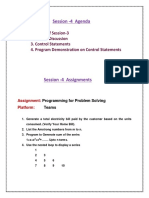0% found this document useful (0 votes)
85 views17 pagesSession-2 - BuzzWords ByteCode Programs
Session 2 of the Java course will cover:
1) Recapping Session 1 concepts
2) Explaining the basic structure of a Java program
3) Discussing Java bytecodes
4) Describing common Java terminology ("buzz words")
5) Learning about conditional statements in Java programs
Students will also be assigned programming tasks involving conditional statements.
Uploaded by
andrajub4uCopyright
© © All Rights Reserved
We take content rights seriously. If you suspect this is your content, claim it here.
Available Formats
Download as PDF, TXT or read online on Scribd
0% found this document useful (0 votes)
85 views17 pagesSession-2 - BuzzWords ByteCode Programs
Session 2 of the Java course will cover:
1) Recapping Session 1 concepts
2) Explaining the basic structure of a Java program
3) Discussing Java bytecodes
4) Describing common Java terminology ("buzz words")
5) Learning about conditional statements in Java programs
Students will also be assigned programming tasks involving conditional statements.
Uploaded by
andrajub4uCopyright
© © All Rights Reserved
We take content rights seriously. If you suspect this is your content, claim it here.
Available Formats
Download as PDF, TXT or read online on Scribd
/ 17





























































